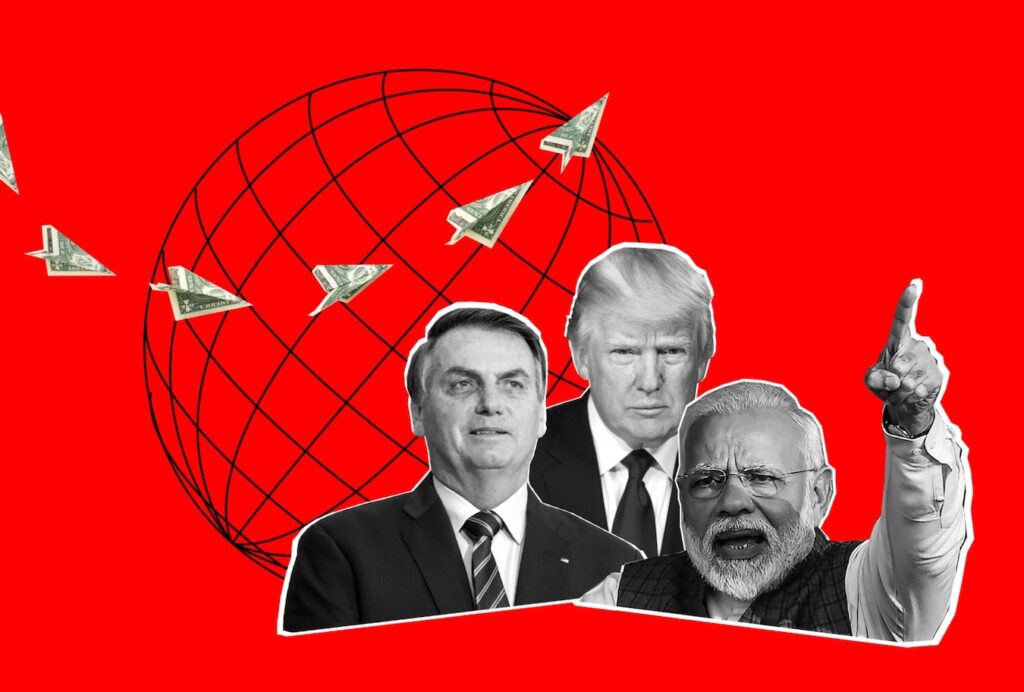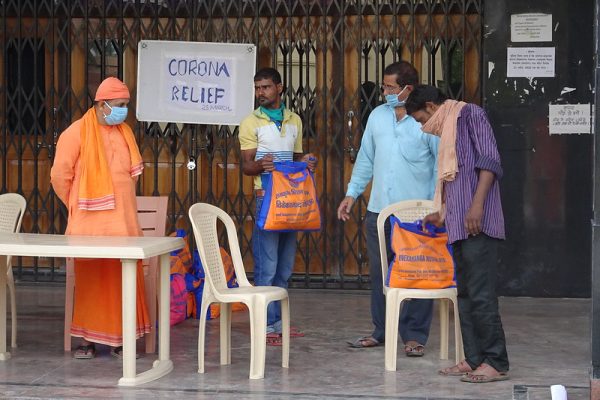It has been four decades since neoliberal globalization began to reshape the world order. During this time, its agenda has decimated labor rights, imposed rigid limits on fiscal deficits, given massive tax breaks and bailouts to big capital, sacrificed local production for multinational supply chains, and privatized public sector assets at throwaway prices.
The result today is a perverse regime defined by the free movement of capital, which moves relatively effortlessly across international borders, even as free movement of the people is ruthlessly controlled by a sharp increase in income inequality and a steady winnowing of democracy. No matter who comes to power, no matter what promises are made before elections, the same economic policies are followed. Since capital, especially finance, can leave a country en masse at extremely short notice—precipitating an acute financial crisis if its “confidence” in a country is undermined—governments are loath to upset the status quo; they pursue policies favorable to finance capital and indeed demanded by it. The sovereignty of the people, in short, is replaced by the sovereignty of global finance and the domestic corporations integrated with it.
This abridgment of democracy is usually justified by political and economic elites on the grounds that neoliberal economic policies usher in higher GDP growth—considered the summum bonum after which all policy should aim. And indeed, in many countries, especially in Asia, the neoliberal era has ushered in noticeably more rapid growth than under the earlier period of dirigisme. Such growth scarcely benefits the bulk of the people, of course: in fact, neoliberal policies are even more highly associated with the growth of income inequality than with the growth of GDP. (Even International Monetary Fund economists Jonathan D. Ostry, Prakash Loungani, and Davide Furceri concede this point in their 2016 article “Neoliberalism: Oversold?”) But neoliberals have sold a powerful response to this objection: a rise in income inequality should be considered an acceptable price to pay for more rapid growth, for it still might mean an absolute improvement in the conditions of the worst off. The fundamental ideological conceit of neoliberalism has been that growth will lift all boats, even if some boats rise much more than others.
There is perhaps no better counterexample to this claim than India, where neoliberal policies were introduced in 1991—spurring both a dramatic rise in inequality and, at the same time, an increase in certain measures of absolute poverty and a decimation of peasant agriculture. In 1982, after more than six decades of strong income taxation, the top 1 percent of earners accounted for just 6 percent of national income, according to Lucas Chancel and Thomas Piketty. By 2014 that figure had ballooned to 22 percent, the highest it had ever been in a century. Meanwhile, as economist Utsa Patnaik has shown in a recent report to the Indian Council of Social Science Research, poverty also went up. In rural India, where the norm for defining poverty has been lack of access to 2200 calories per person per day, the proportion of the poor in total population increased from 58 percent in 1993–94 to 68 percent in 2011–12 (the latest year for which large sample survey data are available). The same pattern held true in urban regions, where the norm has been 2100 calories per person per day: the proportion of the poor increased from 57 percent to 65 percent over the same time period.
Despite these and other cracks in the rising-tide argument that had become all too apparent by the turn of the century, the narrative that neoliberalism would benefit everyone retained a certain currency until the early 2000s, for at least two reasons. First, neoliberal globalization was said to have contributed to the astonishing reduction of poverty in China—the economist Pranab Bardhan has forcefully questioned this conventional story in these pages—and a significant segment of the global middle class did do well: its opportunities expanded thanks to the outsourcing of a range of activities from advanced countries and to a rise in the share of economic surplus, caused by languishing wages but increased productivity of the working class. Second, even those hurt by the neoliberal regime often nurtured the hope that persistent high growth would sooner or later “trickle down” to them—a hope fed incessantly by a media establishment dominated by the middle and upper classes.
This hope more decisively receded, however, as the high-growth phase of neoliberal capitalism ended in 2008 with the collapse of the U.S. housing bubble, giving way to protracted crisis and stagnation in the world economy. As the old prop of trickle-down economics lost its credibility, a new prop was needed to sustain the neoliberal regime politically. The solution came in the form of an alliance between globally integrated corporate capital and local neofascist elements.
This dynamic has played out in countries around the world, from the rise of Narendra Modi in India and Jair Bolsonaro in Brazil to Donald Trump in the United States. To some observers, aspects of the Trump administration—his protectionist proposals, his support of Brexit—reflect a departure of neofascism from neoliberalism. But this analysis overstates the significance of Trump’s breaks from neoliberal orthodoxy at the same time that it neglects the distinctive link between neofascism and neoliberalism in the developing world. For evidence of the connection between neofascism and neoliberalism, we need look no further than the fact that no neofascist political formation has actually imposed controls over cross-border financial flows. Ultimately, it is only by implementing such controls—along with strong domestic welfare policies—that we can escape this alliance.
To assess the prospects for such a shift, it is essential to appreciate the distinctive features of the new fascism. Neofascist groups exist in all modern societies, but typically only as fringe elements. They take center stage in periods of crisis only with the backing of corporate capital, which provides access to massive financial resources and control over the corporate-owned media and other means of opinion-making.
A characteristic strategy of neofascism, like its classical predecessors, is to demonize the “other,” whether Muslims in India or racial and sexual minorities in the United States and Brazil. How exactly this occurs varies from country to country, of course. Such vilification can take multiple forms: it might make no mention of economic crisis at all, concentrating instead on the majority community’s need to get back its “self-respect” that has been allegedly damaged by the minority in the past. Or it might hold the minority responsible for economic woes, quite apart from its alleged role in damaging the majority community’s self-respect. Non-fascist governments are accused of “pandering” to this minority by playing the politics of “appeasement.”
In addition to its attacks on the “other,” neofascism also echoes classical fascism in attacking any and all its critics. It calls them “anti-national” by equating criticism of the government with treachery to the nation. It alleges all kinds of malfeasance in opposition parties (consider the prosecution of Lula in Brazil). It creates a pervasive atmosphere of fear in society—by putting people in jail without trial; by browbeating or weaponizing the judiciary; by abrogating constitutional rights of the people; by terrorizing opposition politicians to defect to the neofascist party in places where they lose elections; by unleashing gangs of thugs on the streets and on social media to attack opponents; by making fake charges against dissenters; by subverting the independence of state institutions; and so on. In all this neofascism is helped by a pliant and docile media. And through it all, it uses its ascendancy to help the corporate sector attack the rights of workers won through decades of struggle.
While all these elements draw on classical fascism, neofascism also departs from its historical predecessors in significant ways. Classical fascism emerged before capital had been globalized, in the sense that it more clearly bore the stamp of its national origin: it was engaged in intense inter-imperialist rivalry with capital from other advanced countries, a rivalry in which it enlisted the support of its own state. The fascist goal was to re-partition a world already partitioned into economic territories. The neofascism of today, by contrast, occupies a regime of globalized finance where inter-imperialist rivalry is muted by the phenomenon of the free flow of capital. Since globalized capital is intent on keeping the entire world open for its free movement, it discourages inter-imperialist rivalry and the fragmentation of the world into rival economic zones.
India provides a vivid illustration of the relation between neofascism and neoliberalism. For one thing, the neofascist Hindu supremacists that came to power in 2014 never had anything to do with India’s anti-colonial struggle (indeed, one of them even assassinated Mahatma Gandhi). Instead they are arch neoliberals, even more so than earlier neoliberal governments; their entire policy stance, even during the pandemic, is centred around keeping the fiscal deficit in check for fear of offending globalized finance, because of which India has been one of the countries offering the most niggardly government assistance to the people affected by the lockdown. India’s government today is also more eager than ever before to privatize public sector enterprises and to provide assistance to corporations, especially a few favored ones. And it has been more keen than any previous government to ensure corporate encroachment on peasant agriculture and petty production.
Indeed, since the earliest days of neoliberalism in India there has been a tragic spike in peasant suicides—more than 300,000 in the two and half decades following 1991. This is because of growing peasant indebtedness. Debt has exploded in the face of higher costs for privatized essential services and a steep drop in profits for peasant agriculture following the withdrawal of government price support in cash crops and a reduction of such support in food grains. The squeeze on peasant agriculture, a sector that employs almost half the total workforce, has been so drastic that the number of “cultivators” has shrunk by 15 million between two censuses, 1991 and 2011. Some became laborers and others migrated to cities in search of non-existent jobs, swelling an army of unemployed or underemployed workers that weakened the bargaining position of the relatively few unionized workers. The GDP growth rate has increased, but there has been a reduction—a halving in fact—in the rate of growth of employment, which has brought it even below the natural rate of growth of the workforce.
The massive peasant agitation currently rocking the country is aimed to roll back three farm laws enacted last year by Modi’s government that only further extend this neoliberal regime. The U.S. administration and the International Monetary Fund, while critical of the Indian government’s handling of the agitation, support the thrust of the three laws. Modi’s neofascism is thus quite unambiguous in its defence and promotion of the neoliberal agenda.
How stable is this global alliance between neoliberalism and neofascism? How long can we expect the prop of neofascist othering to shore up a crisis-afflicted neoliberalism? On the one hand, since global finance will not tolerate wars among major or even minor capitalist powers, one might think neofascism is here to stay. But on the other hand, neofascist regimes are themselves subject to the constraints imposed by the hegemony of globalized finance, and in one respect this limitation is fatally constraining: it vitiates neofascism’s ability to revive employment.
Classical fascism revived employment through government armaments expenditure financed significantly by borrowing—that is, by running a large fiscal deficit. It was through such efforts that Japan had been the first country to come out of the Great Depression in 1931 and Germany had been the first European country to generate a business upswing in 1933 under the Nazi government. As a result, there had even been a brief period, between the end of mass unemployment and the onset of the horrors of war, when the fascist governments had enjoyed sizeable mass support.
Contemporary neofascism, by contrast, is incapable of ending mass unemployment. It is not just that such a goal requires larger government expenditures, already an object of scorn among neoliberals; those expenditures must be financed by taxing capitalists or by a fiscal deficit—both ruled out under neoliberalism. According to neoliberal doctrine, taxing the capitalists, whether through a profits tax or a wealth tax, is supposed to adversely affect their “animal spirits,” as Keynes would put it—that is, the sum-total of attitudes that promote larger investment by the capitalists. A larger fiscal deficit, on the other hand, is frowned upon by finance, as it undermines the social legitimacy of the capitalists (especially of the financial interests who constitute what Keynes called “functionless investors”).
This situation poses a problem for neofascism’s grip on power. Its inability to alleviate the crisis of neoliberalism may lead to its defeat in elections (assuming it does not rig them or bypass them entirely): arguably this is what happened in the United States with Trump’s loss to Joe Biden. But even if neofascism loses in the short term, it will remain a strong contender for returning to power so long as successor governments revert to neoliberal business as usual, as has been the pattern for some time. In order to break this cycle, it is essential that a successor government should not simply resume the old neoliberal policies that produce growing inequality, growing poverty, and growing unemployment. There has to be a decisive shift toward a robust welfare state with revived public social services, public goods, and high employment—precisely the policies that the hegemony of global finance has thwarted.
Quantitatively, such a shift is perfectly feasible. In India, it has been estimated that to institute five universal and justiciable economic rights in the country—the right to food, the right to employment (or full wages if employment is not provided), the right to free health care through a National Health Service, the right to free, publicly funded education (at least up to the school-leaving stage), and the right to a living old-age pension and adequate disability benefit—would require an additional 10 percent of the GDP over what is already being spent under these rubrics. In practice, this would require raising additional resources amounting to 7 percent of the GDP, since the rise in GDP on account of these expenditures will automatically garner extra revenue anyway. (Jayati Ghosh and I discuss these calculations in our contribution to the recent volume We the People: Establishing Rights and Deepening Democracy edited by Nikhil Dey, Aruna Roy, and Rakshita Swamy.)
This 7 percent can be raised through just two taxes, levied only on the top 1 percent of the country’s population: a wealth tax of 2 percent, and an inheritance tax levied on the same group to the extent of just one-third of what is passed down each year. A wealth tax has also gained ground in public debates in the United States following proposals by Bernie Sanders and Elizabeth Warren in the 2020 election season; a few American billionaires even endorsed Warren’s proposal. There is, in short, a general understanding developing across the world that escaping the current conjuncture requires a move toward a strengthening of welfare state measures that have been rolled back during the ascendancy of neoliberalism.
Politically, this shift will be challenging, of course. Attempts to tax the rich will alienate investors and stoke fears of capital flight or insufficient financial inflows to cover the widening trade deficit that would ensue. Sooner or later, the answer must involve control over financial outflows. Such measures do not necessarily spell disaster for the developing world, however. Large, diversified economies can manage the consequences: the short-run difficulties of managing trade deficits—because of a drying up of financial inflows in the wake of such controls—can be overcome, over time, through a diversification of production with the aim of greater self-sufficiency. Small economies can manage by coming together to form local trade blocs. The real cause for concern will be if advanced countries, the “guardians” of globalization, impose trade sanctions and intervene in other ways against countries trying to escape neofascism by adopting such pro-people economic policies.
The neofascist assault on democracy is a last-ditch effort on the part of neoliberal capitalism to rescue itself from crisis. To escape this state of affairs, world public opinion has to be mobilized decisively against neoliberalism, and the support of global democratic movements has to be garnered. Only then will this breeding ground for neofascism at last be undone.
Independent and nonprofit, Boston Review relies on reader funding. To support work like this, please donate or become a member.






